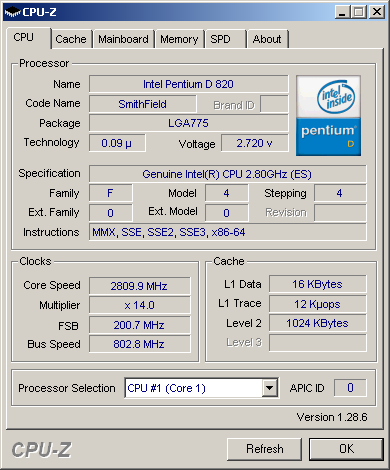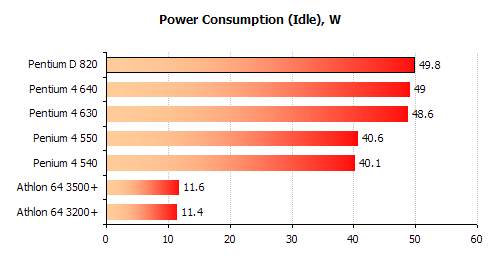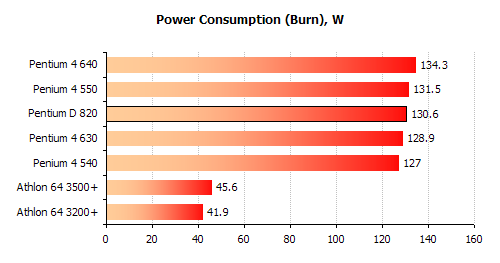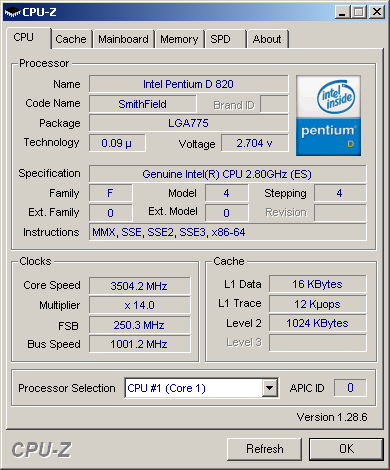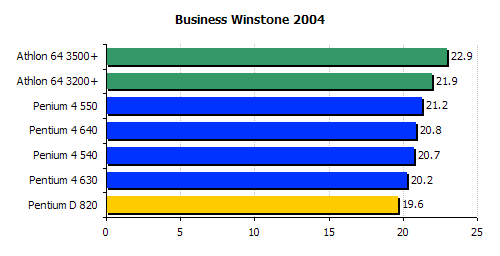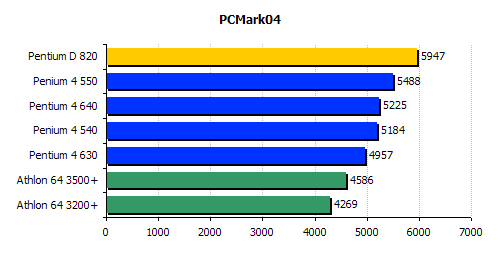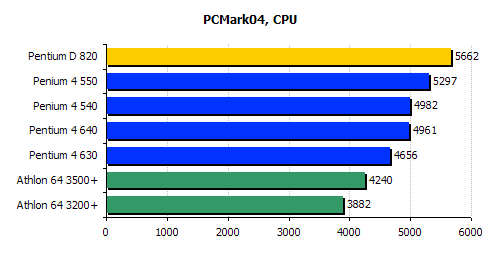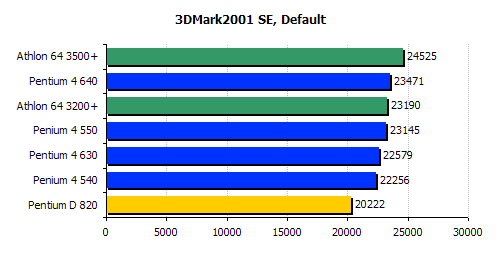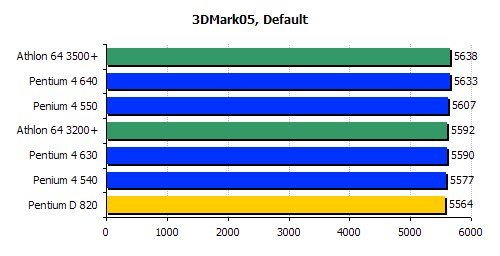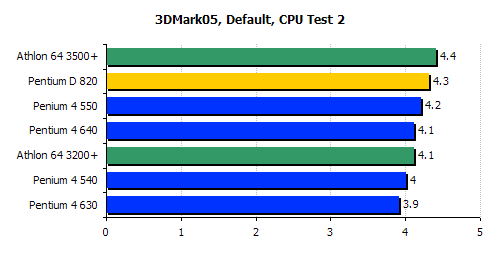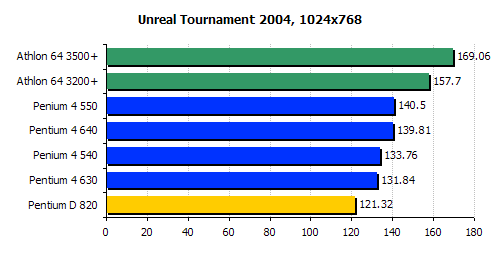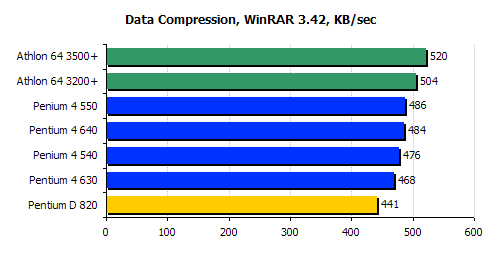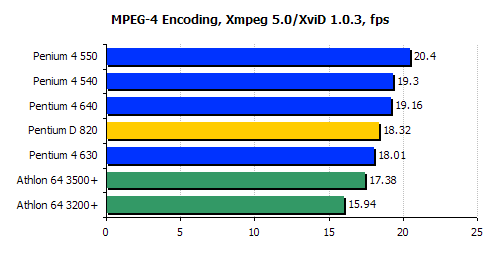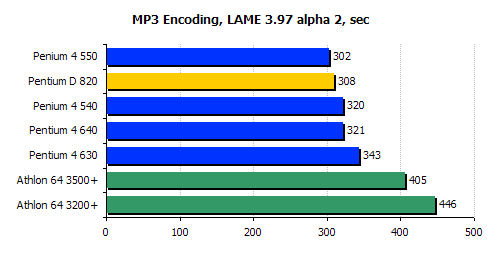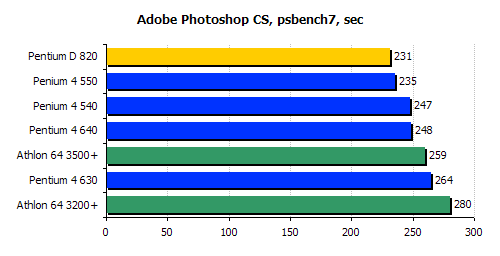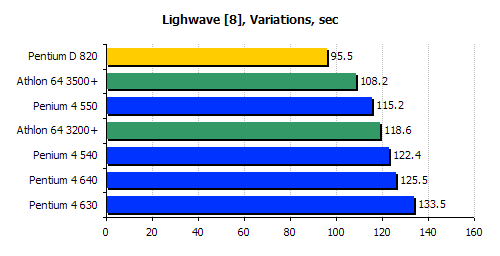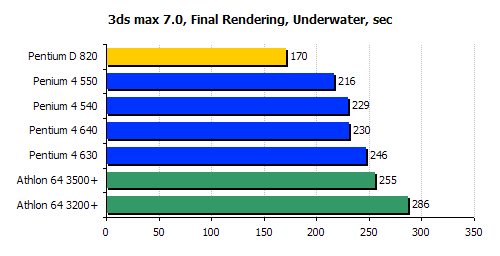INTEL PENTIUM D 820 REVIEW OVERCLOCK BENCHMARK -OVERCLOCKING D820
![]()
|
|
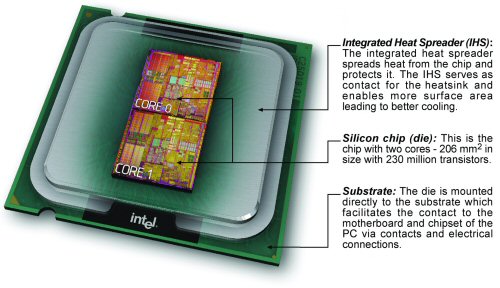 |
||||||||||||||||||||||||||||||||||||||||
| Posted:2006-05-26 By hardware review Number of View:65692 |
|||||||||||||||||||||||||||||||||||||||||
By :hardware review Posted:2006-05-26
intel pentium D 820 review overclock benchmark -overclocking d820Today we would like to talk about the most inexpensive dual-core processor вЂâ€œ the Pentium D working at 2.8GHz. It is currently selling for $241 so it can become a great solution for mainstream systems. Read more in our review now! Look at Pentium D 820
Pentium D 820 processor is the youngest dual-core CPU from Intel based on the Smithfield core. This CPU is none other but a combination of two Prescott dies within a single piece of silicon.
It works at 2.8GHz clock frequency and has no Hyper-Threading Technology support. The detailed formal characteristics of this solution are given in the table below:
I would like to draw your attention right away to a few curious things that you can see in the specification. Firstly, Pentium D 820 processor does not support Intel Enhanced SpeedStep technology, which is available in all other dual-core processors on Smithfield core. The reason for this is the clock frequency multiplier, which equals 14x for this CPU. It is the minimum clock frequency multiplier for all processors based on modifications of Prescott core. For the same reason, Pentium D 820 does not support such technologies as C1E (Enhanced Halt State) Technology and TM2 (Thermal Monitor 2) Technology, which also require dynamic change of the CPU clock frequency multiplier. Secondly, the low TDP level of the Pentium D 820 processor is also quite remarkable here. All other Pentium D CPUs and Pentium Extreme Edition 840 feature the thermal design power of 130W. Moreover, this characteristic of the Pentium D 820 processor is even lower than that of the top single-core Pentium 4 solutions: their TDP equals 115W. This gives us some hope that Pentium D 820 will turn out not so hot as the previously reviewed Pentium Extreme Edition 840 and will allow using pretty simply cooling solutions. Besides, relatively low heat dissipation and power consumption of the Pentium D 820 processor should make it possible for this processor to work just fine in mainboards without “enforced” CPU voltage regulator. Other than that, Pentium D 820 doesnвЂâ„¢t boast anything else different from its elder brothers. CPU-Z utility provided the following info about this processor:
The operating system sees this CPU as two processors, which is actually not surprising at all, because it has two physical cores and doesnвЂâ„¢t support “virtual multi-core architecture", i.e. the Hyper-Threading Technology. intel pentium d 820 Power ConsumptionWe couldnвЂâ„¢t disregard testing the power consumption of the Pentium D 820 processor, of course. It was the low TDP Intel set for this processor that stimulated our interest to this parameter. If the power consumption (and, consequently, the heat dissipation) of this CPU is not that high, it will be even more attractive for the users. The diagrams below show the results of power consumption measurements for the Pentium D 820, Pentium 4 and Athlon 64 CPUs offered at the same price point today. We used the special S&M utility to load the CPUs to their maximum for a more illustrative picture. You can download this utility here.
Since Pentium 4 processors participating in this test support C1E technology, their working frequency drops down to 2.8GHz in idle mode. That is why the dual-core Pentium D 820 processor working at the same frequency under any workload consumes a little bit more power than its single-core fellows. However, the power consumption of the Pentium D 820 processor in idle mode is just a little bit higher than that of the Pentium 4. As for Athlon 64, it is a few times less power-hungry here. And the remarkable thing is that we tested it with CoolвЂâ„¢nвЂâ„¢Quiet disabled!
Even under the maximum workload Athlon 64 CPUs (we tested those on Venice core) also boast considerably lower power consumption. You may consider it funny but the Athlon 64 processors under maximum workload consume about the same amount of power as the Pentium 4 processors in idle mode. This is something to think about, donвЂâ„¢t you agree? As for the power consumption of our todayвЂâ„¢s hero, Pentium D 820, it eats up about the same amount of power as the Pentium 4 processors from the same price group working at 3.0-3.4GHz. By the way, these processorsвЂâ„¢ TDP is set at 84W, so it looks like Intel set the 95W barrier for its Pentium D 820 just in case. intel pentium d 820 OverclockingWe havenвЂâ„¢t yet undertaken any overclocking experiments for dual-core CPUs. Nevertheless, we couldnвЂâ„¢t leave out this exciting aspect, because there will definitely be enthusiasts among you who would wish to squeeze even more speed from their dual-core processors. Especially, the youngest processor model of the Pentium D family is simply calling for an overclocker: it just has to overclock at least up to the level of the top processor in this product line, which works at 3.2GHz. Moreover, keeping in mind that Smithfield is a combination of two Prescott cores of E0 stepping on a single semiconductor die, we can expect even more fruitful overclocking: the latest CPUs based on Prescott and Prescott-2M core proved easily overclockable beyond 4GHz bar. However, dual-core processors should have more specific and sophisticated overclocking procedures than their single-core fellows. The main problem will inevitably lie with their high heat dissipation. All in all, we couldnвЂâ„¢t help carrying out a few practical experiments. For our Pentium D 820 overclocking experiments we assembled a platform on ASUS i955X based P5WD2 Premium mainboard. The cooling was provided by a pretty efficient Zalman CNPS7700Cu cooler. During overclocking we didnвЂâ„¢t increase the processor Vcore. The CPU was overclocked by raising the FSB frequency: the clock multiplier of the Pentium D 820 processor is locked just like by IntelвЂâ„¢s single-core solutions. The PCI Express and PCI bus frequencies were fixed at the nominal values. The memory frequency was reduced a little bit so that the Corsair CM2X512A-5400UL memory modules didnвЂâ„¢t turn into a bottleneck during overclocking.
The actual overclocking of Pentium D 820 processor started quite unexpectedly. We managed to raise the FSB frequency tThe system started and booted-up normally at this speed and allowed running all sorts of small utilities (including single-threaded ones) without any problems. However, when we took a closer look at the system functioning in these conditions, we saw that it could not provide fully-fledged functionality in this case. The Zalman CNPS7700Cu cooler couldnвЂâ„¢t cope with its task when the CPU got loaded heavily.o 250MHz in no time and without any special effort. This brought the CPU clock rate up to 3.5GHz. The temperature kept growing and the CPU would shut down. Since Zalman CNPS7700Cu is a pretty powerful air cooler, the conclusion we can draw here is not very optimistic. You need an extremely efficient cooling solution, a water-cooling system, for instance, if you intend to try overclocking your dual-core processor. We still decided it would be interesting to find out what is the maximum frequency our processor can work at stably with the air cooler, because this type of cooling is currently used in most computer systems. We reduced the FSB frequency to 240MHz and continued out stability tests. The CPU was working at 3360MHz in this case. The results obtained in this case turned out even more interesting. The thing is that the system remained stable, the CPU temperature stayed within the acceptable range, and all major tests would run smoothly. However, when we started a benchmark supporting multi-threading, some weird things began happening. The results appeared suspiciously low in this case. When we launched two independent copies of a single-threaded application (we used WinRAR archiving utility), we managed to reveal a very interesting effect: Pentium D cores can get into thermal throttling independently. In other words, the first core continued working at its normal speed, while the second core started missing clocks losing its speed tremendously. The strange thing is however, that the temperature still remained within acceptable range of 75-78oC. Testbed and MethodsAs we have promised in the beginning of this article, Pentium D 820 will compete in our performance tests against other processors offered at the same price point. Among them are AMD Athlon 64 3200+ and 3500+, Intel Pentium 4 540 and 550 and Pentium 4 630 and 640, which are priced between $200 and $270. This test session will allow us to conclude whether it would be a good idea to base your platform particularly on the Pentium D 820 CPU. Our platforms were assembled with the following components:
Performance in Office ApplicationsBussiness winstone 2004 d 820 benchmark
The results of Pentium D 820 tests in signle-threaded office applications are pretty logical: dual-core CPU is slower than its single-core fellows with higher clock frequency. Performance in PCMark04, 3Dmark 2001 SE and 3Dmark05 benchmarkpcmark 2004 d 820 benchmark
PCMark04 benchmark does support multi-threading therefore Pentium D 820 looks very attractive here.
Unfortunately, we canвЂâ„¢t say the same about 3Dmark benchmark family, because they do not use the second processor core, just like most contemporary game
However, 3Dmark05 has two purely processor tests working in two threads: one of them emulates the shaders and another one calculates the physical environment model. In this case Pentium D 820 proves very impressive, yielding to Athlon 64 3500+ only once. Note that none of the Pentium 4 processors from the same price range can compete with Pentium D 820 here. Performance in Games d 820 gaming benchmark
The situation with gaming applications has long been quite clear. The developers of this software use only single-thread algorithms, that is why dual-core processors cannot provide any benefits in games. And it looks like will not for quite a long time. d 820 Performance during Data Compression
Pentium D 820 showed pretty low results in WinRAR, because this archiving utility uses only one core of the dual-core processor. So, relatively low clock frequency of only 2.8GHz prevented it from competing successfully with pentium 4 CPUs working at 3.0-3.4GHz and Athlon 64 processors boasting very efficient low latency memory subsystem. Performance during Audio and Video Encoding
During audio and video encoding with different codecs, Pentium D 820 processor demonstrated pretty good results. It proved faster than Athlon 64 processors of the same price in all tests, and in LAME, Windows media Encoder and DivX it also outperformed single-core Pentium 4 CPUs. Performance during Image and Video Editing
Professional Adobe applications for image editing and video editing/processing are well optimized for multi-processor systems. That is why Pentium D 820 performed so well here. Performance during 3D Rendering
Pentium D 820 is an indisputable winner in 3D rendering tasks. No wonder: this type of algorithms can be easily split into a few parallel threads. ConclusionIn this review we tried to compare the processors from the mainstream pricing segment of the todayвЂâ„¢s CPU market. The situation here changed when Intel announced its dual-core Pentium D processors. The lowest model in this family working at 2.8GHz costs $241, and hence is qualified formally for use in typical mainstream computer systems. So now the users can choose not only between Athlon 64 and Pentium 4. Among the candidates for this position we now also have Intel Pentium D 820, which performance we have just compared against that of the other solutions falling into the $200-$300 range. According to our tests, the launch of an inexpensive Intel processor can seriously affect the usersвЂâ„¢ preferences. Pentium D 820 appears faster than its single-core rivals in a pretty big number of test applications. Although this is mostly true for Pentium 4. Athlon 64 solutions retain their leadership in those tasks where they have been the best. But in many applications where the winnerвЂâ„¢s laurels used to belong to Pentium 4 CPUs, we now see Pentium D 820 raising the performance bar even higher. So, with all certainty, we can recommend using the new Pentium D processors for multi-threaded environments and applications optimized for multi-processor systems. In this type of tasks, the new Intel dual-core CPU can show the best results. If you consider yourself a gamer or if you rarely use multi-threaded applications, you should still go for your ideal choice: Athlon 64. As for the Pentium 4 processors, they sometimes appear faster than the dual-core Pentium D, but only in those tasks where the absolute leadership is already taken by Athlon 64. However, you should also keep in mind a few negative things about the new Pentium D 820. This is primarily the need to buy a new mainboard for it. Unfortunately, IntelвЂâ„¢s dual-core newcomer is compatible only with new mainboards on i955/i945 chipsets. And these boards are still not so widely spread and cost quite a bit of money. So, it would be a way too early to cross out the good old Pentium 4, which doesnвЂâ„¢t suffer from any compatibility issues
we would be happy to answer for your question . if you have suggestion or comment
regarding this review our support would be glad to help just join our forum and ask u will get the best answer
to discuss check our forum section :-) RATE THIS REVIEW | |||||||||||||||||||||||||||||||||||||||||
![]()

intel pentium D 820 review overclock benchmark -overclocking d820
intel pentium D 820 review overclock benchmark -overclocking d820


7600gt review
7600gt is the middle card range.
We already benchmarked this video card and found that ...

 geforce 8800gtx and 8800gts
geforce 8800gtx and 8800gts  Xtreview software download Section
Xtreview software download Section  AMD TURION 64 X2 REVIEW
AMD TURION 64 X2 REVIEW  INTEL PENTIUM D 920 , INTEL PENTIUM D 930
INTEL PENTIUM D 920 , INTEL PENTIUM D 930  6800XT REVIEW
6800XT REVIEW  computer hardware REVIEW
computer hardware REVIEW  INTEL CONROE CORE DUO 2 REVIEW VS AMD AM2
INTEL CONROE CORE DUO 2 REVIEW VS AMD AM2  INTEL PENTIUM D 805 INTEL D805
INTEL PENTIUM D 805 INTEL D805  Free desktop wallpaper
Free desktop wallpaper  online fighting game
online fighting game  Xtreview price comparison center
Xtreview price comparison center 

Important: It appears that you are using AdBlocking software.
This site is supported by advertising revenue. If you are reading this site without the accompanying advertisments, you are harming the owner who provides this information at significant expense. You may, without your knowledge, have software on your computer that deletes ads. Or, if you have installed AdBlocking software, you should know that it may block much more than banner ads, rendering some sites unusable.
You will not receive it again during this session (cookies required.)
- The new version of GPU-Z finally kills the belief in the miracle of Vega transformation
- The motherboard manufacturer confirms the characteristics of the processors Coffee Lake
- We are looking for copper coolers on NVIDIA Volta computing accelerators
- Unofficially about Intels plans to release 300-series chipset
- The Japanese representation of AMD offered monetary compensation to the first buyers of Ryzen Threadripper
- This year will not be released more than 45 million motherboards
- TSMC denies the presentation of charges from the antimonopoly authorities
- Radeon RX Vega 64 at frequencies 1802-1000 MHz updated the record GPUPI 1B
- AMD itself would like to believe that mobile processors Ryzen have already been released
- AMD Vega 20 will find application in accelerating computations
- Pre-orders for new iPhone start next week
- Radeon RX Vega 57, 58 and 59: the wonders of transformation
- ASML starts commercial delivery of EUV-scanners
- The older Skylake processors with a free multiplier are removed from production
- Meizu will release Android-smartphone based on Helio P40
- AMD Bristol Ridge processors are also available in American retail
- The fate of Toshiba Memory can be solved to the next environment
- duo GeForce GTX 1080 Ti in GPUPI 1B at frequencies of 2480-10320 MHz
- New Kentsfield overclocking record up to 5204 MHz
- Lenovo released Android-smartphone K8



computer news computer parts review Old Forum Downloads New Forum Login Join Articles terms Hardware blog Sitemap Get Freebies



